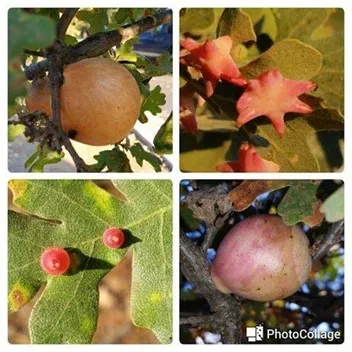By Maria Murrietta, Program Coordinator, UC Master Gardeners of SLO County
What is a Gall?
- A gall is a growth of plant tissue that starts with a chemical and/or mechanical stimulus (insects, mites, fungi) to an organism which increases the organism’s production of plant growth hormones, which can include auxins, gibberellins and others.
- Galls are made of cells that are more numerous or larger than normal plant cells, or plant.
- An insect gall forms because of the plant’s response to the insect’s egg laying, presence of the egg and/or feeding stimulation by the larva. Plant cells are usually modified and enlarged, the altered plant tissue surrounds the egg or larva and the gall protects and feeds the gall-maker.
Where are galls located?
- Usually on rapidly growing plants or plant parts.
- On catkins, seeds, flowers, petioles, branches, stems and roots; most occur on leaves and buds.
What do galls look like?
- Some galls are single-chambered (monothalamous) and contain only one gall-maker. Others are multi-chambered (polythalamous) and contain many gall-makers.
- The most common galls are described as blister, bud, bullet, oak apple, roly-poly, rosette or stem galls.

What are the most common gall-making insects?
- Most gall-making insects are adelgids, phylloxerans, psyllids, gall midges or gall wasps (cynipids).
- Of the more than 2,000 gall-making insects in the U.S., over 1,700 are gall midges or gall wasps.
Can insect galls hurt a tree?
- Leaf galls can be abundant and noticeable, but are not physically damaging.
- Occasional stem galls should not be physically damaging or reduce tree growth. However, severe infestations by some gall-making species may alter branch angles, cause branch dieback or tree decline.
- If properly maintained, established trees do survive and outgrow a gall infestation in the landscape.
Are galls ever beneficial to have?
- Some galls/gall-makers are used in weed biological control programs.
- Galls containing tannic acid (e.g., oak galls) have been used to make inks and dyes and to tan leather.
References
Adapted from Eileen A. Buss, Associate Professor, Entomology and Nematology Dept., UF/IF
Additional Resources
Gall Makers-Various Organisms. UC IPM. http://ipm.ucanr.edu/PMG/GARDEN/PLANTS/INVERT/gallmakers.html
Life in the Undergrowth takes a close look at the tiny wasps responsible for oak galls. Oak Tree and Wasp Eggs | Life in the Undergrowth | BBC Studios
